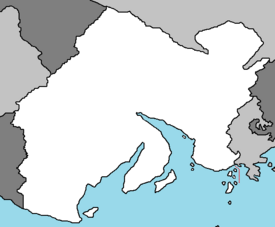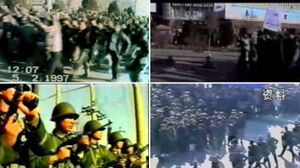Zhinca
People's Republic of Zhinca Žinca Řɨnmin Gunhəguə | |
|---|---|
| Motto: "Weili Zyju" "For Liberty" | |
| Anthem: Vəmu di Lënminŝin[1] ("Zhincian National Anthem") | |
 | |
| Capital and largest city | Nanžin 00°00′S 00°00′S |
| Official languages | Zhincan |
| Ethnic groups |
|
| Demonym(s) | Zhincian • Zhin |
| Government | Nationalist Military Dictatorship |
• Chairman | Xi Čüanguy |
| Lun Fužin | |
| Min Zhongyue | |
| Liang Zemin | |
| Feng Jiangwang | |
| History | |
• Annexation | 12 XXXXX |
| Area | |
• Total | [convert: invalid number] (5th) |
• Water (%) | 0.0 |
| Population | |
• 2018 estimate | 68,558,984 |
• Density | 137.1/sq mi (52.9/km2) |
| GDP (nominal) | 2020 estimate |
• Total | 585.7 billion |
• Per capita | 16,200 |
| Gini (2019) | medium |
| HDI (2018) | very high |
| Currency | Zhincian yüan (RMY) |
| Time zone | UTC+9 |
| Driving side | left |
| Calling code | +650a |
| Internet TLD | .zn |
Official History
Antiquité
Signs of intelligent, sapient life in the region can be traced back as recently as 14,000 BCE, during the last glacial episodes of the World. The first settlers probably lived primarily as short hunter-gatherers due to the massive glaciers and permafrost that, until recently, enveloped the southern region of Zhinca for much of its history. They subsequently made Zhinca's first crude "fire" underneath a collapsed cave in the middle of a snowstorm. Despite the popular allegations of the Zianists that every person on the planet drowned during the Greatest Flood, recent historical analysis of recent events has safely assured everyone that the humans of Iearth probably survived thanks to their innate mental and physical abilities. However, the majority of them subsequently went north, to east and west, to greener pastures and when Ahno arrived he found barely anyone. Displeased by their wanderlust attitude, he asked the Heavens to strike lightning upon them.
The prior original inhabitants of the region that now constitute Zhinca, the native Suson, intermixed with various immigrating peoples documented in two periods, first; the proto-Beleroskovic expansion to the area, second; the much more recent Yuanic migration. At the dawn of the regional Iron Age of which Zhinca didn't participate in, a mysterious people came, known today as the Sakyi civilization. Many alt-historians still haven't agreed on the origins of this obscure tribe. According to the most agreed-upon opinion, the Sakyi were simply proto-Yarlungic speakers, while famous conspiracy theorist Dr. Alisher Morgenshtern, believed they were humanoid, blonde extraterrestrials from a planet far, far away (more commonly known as Earth).
After the succeedance of the Sakyi, the Yarlung peoples spontaneously migrated all over the region, and for multiple reasons established it over the Zhincan tundra. Documented by Yuaneze explorers, the Yarlungic tribes were an ethnolinguistically similar grouping of "uncivilized barbarians", who had run away from their cruel Imperial Emperors at some point. One of the Yarlung tribes established Zhinca's historic northern capital, as a huge vacation yurt. Each of the aforementioned nations and tribal peoples participated in the ethnic formation of the Zhincan people.
Moyen Âge
In the beginning, Northeastern Zhinca and its peoples were subjugated by the Beleroskovians while the rest was inhabited by so-called barbarians. During this period, a major mythological figure started to exist in oral tradition amongst the natives of the Zhincan region. It was Luosaita, a wise philosopher, teacher, and a well known botanist (he famously died stuck inside of a large bush). Known for his erratic wisdom and creativity, Luosaita studied in various cities and soon after invented the Yarlungic (now known as Old Zhincan) logographic script, to which he gave credit to a large rock in which he proudly named after himself in a dated Beleroskov-language stone manuscript. The invention of the new alphabet was the beginning of native literature and proved a powerful factor in the uplifting of the hunter-gatherer national spirit.
Époque contemporaine
In the early modern age, the Zhincan nation under the faltering Nechtzamp Dynasty was in the midst of a royal power struggle between five descendants, and so was quite literally unable to do anything at all. As a result, the country became a land of contention between numerous countries during this turbulent period. After a legendary modded Red Alert Medieval game, the Beleroskovians finally won and took over the state. However, Barbarian Hordes and Co became very, very, dissatisfied and so they invaded western Zhinca, in an attempt to take it for themselves. During the same time, a drunken rag-tag army of Red Turban pirates hailing from the Yuaneze borderlands plundered Nanzhin and killed about 3-10 thousand people which irritated the Zhincans.
At this point in time as well, Yuanic speakers started to migrate to the region, which slowly turned the native Yarlungic language into a minority language, instead replaced by heavily Yarlungic-influenced Yuanic dialects. These dialects would soon form the basis for the most esteemed Zhincan language.
Nothing happened during this period
Almost nothing of interest happened during this time.
People's Democratic Republic of East Zhinca
Zhinca, being the outdated carcass of nomadic civilization it had always been, was taken over quite easily by Beleroskov-supported socialist revolutionaries during the 1930s, thus a new controversial chapter of history began in Zhinca. For what it's worth, totalitarian communist rule proved to be a refresher in contrast to the violent warlord-era anarchy that plagued the country during the last 30 years or so. The people then enjoyed a period of relative, state-controlled stability under the new socialist, Beleroskov-directed satellite government, as they were allowed to eat and sleep whenever they wanted during the first couple of years. Furthermore, they started to receive medical aid and other notable provisions like horses, deer, concrete buildings, etc. Therefore, its first President, Jozyef Broz became a very beloved leader and the Zhincan population organized many military parades, honouring his great baldingness. Jozyef Broz died in June 15, 1950, and Dearest Leader Maw replaced him as the Leader of Eastern Zhinca.
Unfortunately for the Zhincans, the late leader, Dearest Leader Maw didn't like them and their thoughts much and so began an era of renewed fear, paranoia and violence. In his dislike for "My Bourgeoisie Opponents", he committed many terrible atrocities during his reign. As with various other ethnic minorities (e.g. Slavic speakers) who lived in the People's Democratic Republic, tens of thousands of them were either brutally executed by the politruk or sent to ze island gulags. To add further, Maw made the country embark on a "Zhincanisation" campaign, attempting to make its society adopt Yarlungic clothes and loanwords, which continues through successive Zhincan governments to this day. However, this is of slightly minor importance: The World War never reached Zhinca, hence the people were saved from another destructive genocide. Imagine what would have happened, if barbarians conquered Zhinca for the 1000th time...
Soon after Maw's sudden death in 1959, President Teng Syauping took the helm of the country's leadership after a tenuous political struggle. During Syauping's reign, quality (not quantity) of life in the People's Democratic Republic of Eastern Zhinca began to see renewed, although very slow improvement. Beleroskov influence hit its peak during Teng's tenure as President, and the country briefly joined the United Communist and Socialist States. The Zhincan national athletes at the time were quite successful in sports, like wrestling, weightlifting and of course the famous national sport; doping. They participated in all the worldwide Games, bringing much glee to Dearest President Teng.
Modern Era
5.25 Incident (WIP)
Geography
Government and politics
Military
The Armed Forces of the People's Republic of Zhinca consist of the Land Forces, Naval Forces, Air Forces, Internal Troops and the National Guard. Their Supreme Commander-in-Chief is the Supreme President of Zhinca, with management being handled by the Ministry of Defense, headed by the Minister of Defense, and the General Staff. The military is tasked with the defense of the "Zhincan State, Nation, and People" as well as "external and internal enemies". The military relies on conscription through its 3 year compulsory military service for males over the age of 21, with reserve obligations lasting until the age of 60.
The military and its apparatus is highly influential in the political and economic life of Zhinca, with some analysts describing it as a "state within a state". It has staged a total number of 10 coups since its inception. In recent years, the Zhincan military has embarked on a modernization initiative, which had been mired with scrutiny due to the immense mishandling and corruption within the program. Critics of the modernization program claim of money-laundering associated with many of the program's projects.
The Zhincan military currently does not participate in any conflict outside its borders, although it is currently engaged in a low-level insurgency against a number of minor seperatist groups in western Zhinca.





